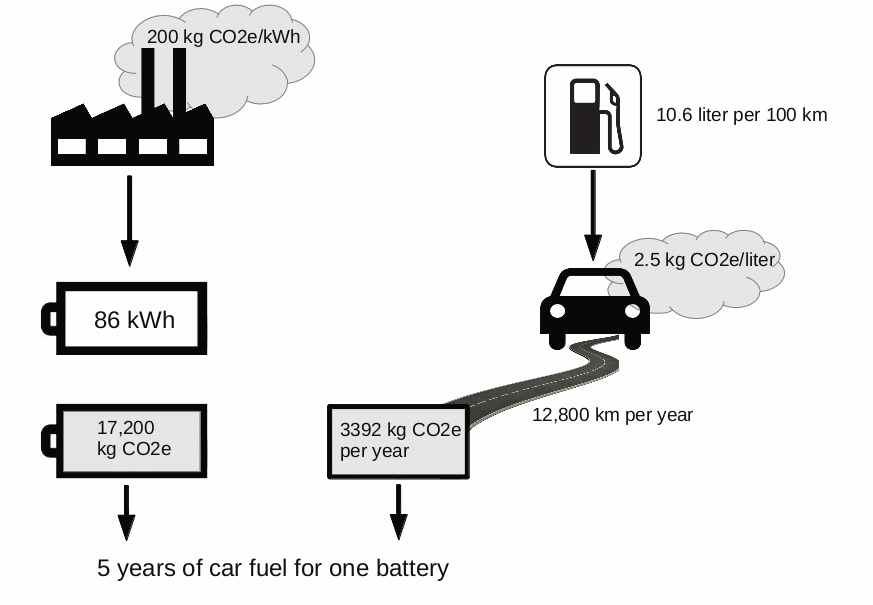Eight years' worth of petrol?
Electric cars are a total hoax!
The embedded greenhouse gas emissions of a Tesla car battery are the equivalent of 8 years worth of emissions from a normal car!
On 21 June 2017, social media picked up on a press release by the IVL Swedish Environmental Research Institute.
As is often the case, the facts weren't necessarily false but taken out of context. They were also not really new.
The authors reviewed existing literature. Their main conclusion was that the available data regarding embedded environmental impacts of Lithium ion batteries are very patchy and that this situation needs to be improved.
 The main numerical finding was that greenhouse gas emissions associated with current production of these batteries are likely in the range of 150 to 200 kg CO2e per kWh of capacity.
So, let's consider. Tesla car batteries have a capacity of 86 kWh. Using the high factor
of 200 kg CO2e per kWh and the average fuel efficiency and distance driven per year in Australia (ABS, for 2016), it turns out that
the embedded emissions in the battery equal the emissions of 5 years' worth of fuel.
The main numerical finding was that greenhouse gas emissions associated with current production of these batteries are likely in the range of 150 to 200 kg CO2e per kWh of capacity.
So, let's consider. Tesla car batteries have a capacity of 86 kWh. Using the high factor
of 200 kg CO2e per kWh and the average fuel efficiency and distance driven per year in Australia (ABS, for 2016), it turns out that
the embedded emissions in the battery equal the emissions of 5 years' worth of fuel.
In other countries this could well be 8 years, depending on average fuel efficiency and distance driven. When using the lower factor of 150 kg CO2e per kWh for the battery, the estimate for Australia comes down to just under 4 years. Still, a lot of petrol or diesel!
Before joining the anti-environmentalist frenzy, though, we should consider the following. The Tesla is not an average car;
it competes with the high end of the market. Comparing it to the average fleet is not appropriate. Applying this finding to all electric vehicles isn't either: the battery capacity of a Nissan Leaf is about 24 kWh which equates to 1 to 1.5 years' worth of petrol.
An environmental payback time of several years is not necessarily bad. These batteries are relatively new technology, produced in relatively low quantities, and as such by definition less efficient in production.
This will improve over time. The point of electric cars is not just to mitigate climate change, but also or in the short term even more so to reduce air pollution in the urban environment. In the long term, batteries can be produced with renewable energy, thus reducing the footprint. Fossil fuels will always be fossil fuels.
It is interesting to consider what this may mean for home battery storage in combination with solar energy.
Capacities of those units typically range from 6 to 14 kWh. With a similar back-of-the-envelop calculation,
the greenhouse-gas payback time would be up to six months, compared to the emissions associated with average grid power.
Greenhouse-gas payback times for solar photovoltaic cells are of the order of a year in terms of average Australian grid power, or probably less for state-of-the-art solar cell technology.
A system of solar cells with battery storage does not necessarily need to have a longer environmental payback time than one without. This will depend on how the system works, whether it is grid connected or not and how the trade-off between delivering to the grid and storing for later private use is made, amongst others.
More reliable information about environmental payback times of renewable energy options, including reduction of emissions other than greenhouse gases, should be available to consumers.
It is crucial not to hide the embedded environmental impacts associated with materials used in renewable energy harvesting. Nothing is perfect, and transparent and constructive communication about environmental payback times will allow people to make decisions based on robust information rather than fearmongering.
The report published by the IVL Swedish Environmental Research Institute is called
The Life Cycle Energy Consumption and Greenhouse Gas Emissions from Lithium-Ion Batteries. Authors Mia Romare and Lisbeth Dahllof, May 2017